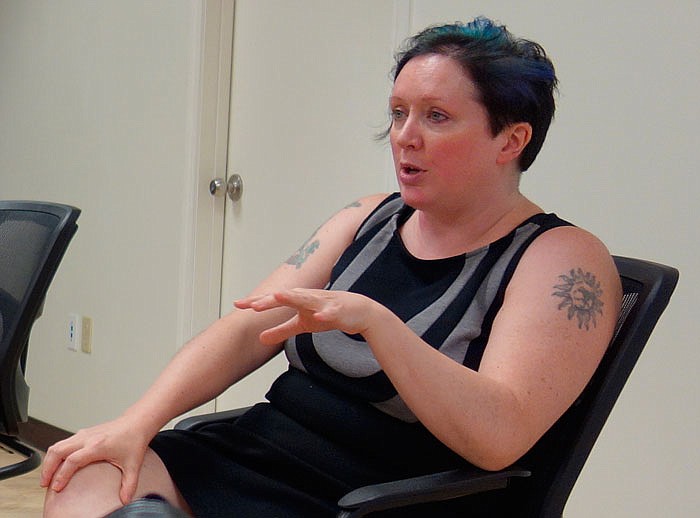Dr. Angela Speck of the University of Missouri has a few titles behind her name - some serious, some not so much.
Professor of astrophysics. Director of astronomy. Eclipse tsar. Stellar mortician. Antidote to traditional teaching.
On her visit to Fulton Wednesday evening to meet with the local committee planning 2017 eclipse activities, she had a burst of brilliant colors feathering from her hair and a tattoo on each arm.
"I'm not what you expected, am I?" she said, laughing, when introduced.
Speck arrived at MU in 2002 and helped build the univesity's astronomy program. She's mentored dozens of students and is an elected member of the American Astronomical Society Council - and more. While her primary interests include stellar evolution,
astromineralogy and dust around evolved stars, she is also focused on next year's solar eclipse projected to cross right over Callaway County.
"I'm chairing the National (Science Foundation's) committee to celebrate the eclipse," she said. "We've been trying to plan for this thing for a few years. I'm willing to do whatever it takes to make this a success."
That means she's speaking to towns, cities, schools, libraries and service clubs, educating people about what the eclipse is and what to expect when it happens on Aug. 21. Speck also is spearheading Columbia's eclipse preparation and helping Callaway County's "Light and Shadow" eclipse committee plan, as well.
"I have a bunch of talking points I've put together," she said. One videoed presentation can be seen on the University of Missouri's website at missouri.edu/eclipse.
In Callaway County, the eclipse effects will come between 1:12-1:15 p.m. Aug. 21, a Monday. Events are being planned starting the previous Friday.
Speck said all communities falling within the most-intense eclipse-affected areas can expect to see their populations doubled or even quadrupled on the day.
"Folks don't realize how many people will come," she said, adding the example of Baja, Mexico, a prime viewing spot for a previous total solar eclipse. "Mexico closed the country. And this was in 1991, pre-email and internet."
The coming eclipse will travel from northwest to southeast, and total darkness will hit Columbia at 1:12 p.m., with Callaway County experiencing the same soon after.
Speck pointed out Missouri, being dead center in the nation, is about 900 miles from anywhere and easily accessed.
"It's a long one-day drive, but it's doable," she said. "One thing that makes this eclipse unique is most of it will be over land for a long time - and over one country."
And that country, compared to some others, is safe for visitors with a language commonly spoken. In other words: People will come, not just from around America, but from other countries.
"I think half of England is coming to my house," she said, adding her original home is Yorkshire. "You don't need a visa to come to the United States. Missouri is kind of the sweet spot."
In fact, some states are pretty booked as far as hotel reservations and even camping spots are concerned.
"Eastern Oregon is the best place to see it, but there's no place to stay," Speck said. "Wyoming is pretty much booked. Nebraska - Lincoln's right on the edge (of good viewing). I think the whole of Missouri will be very busy, and we also have one of the longest durations (of darkness) - two minutes and about 42 seconds."
Preparation is key, she warned.
"How do you deal with the traffic? The state troopers are going to be busy," Speck said. "This is going to be busy. We won't know the full extent until two weeks out."
Callaway County officials might want to think about creating campsites, remembering they need to assure plenty of sanitary infrastructure - portable toilets - is available. Will there be generators? Will grocery stores and restaurants have enough food available?
"I have four bathrooms at my house, but I have 30 guests coming at this time," she said.
Regina Ruppert, of Serenity Valley Winery ,said they are planning to accommodate guests and events at their property west of Fulton.
"We plan to mow the hay field and put up permanent campsites," she said.
It's not going to be hard attracting visitors, Speck said. Managing the ones who come - that should be the concern.
"You need to have as many places (to view the eclipse) as possible," she cautioned. "That keeps it spread out."
She also advised the medical community to be prepared as Missouri is blistering hot in August.
"There will be heatstroke, no doubt," she said, adding there will be an official document coming from NASA and the National Science Foundation on how to safely view the eclipse. "That will be the official advice."
When the eclipse begins, people will first notice a change in colors, and animals will react, Speck said.
"When it gets dark, animals will react like it's night," she said. "There will be a twilight, then full-moon darkness in a few seconds."
People may see light shimmering around the sun's corona, and the edges of the horizon will look like twilight, she added.
"And you'll see stars," she said.
Partial eclipses are common - but total solar eclipses are not.
"The last time there was a total eclipse here (in central Missouri) was in 1442. The next one will be in 500 years," she said.
In 1806, a total eclipse cut across the northwest corner of the state, and another in 1869 cut across the northeast corner.

